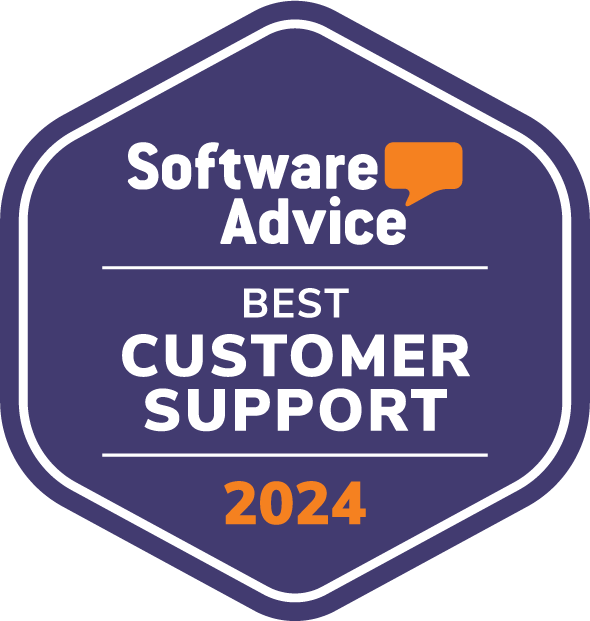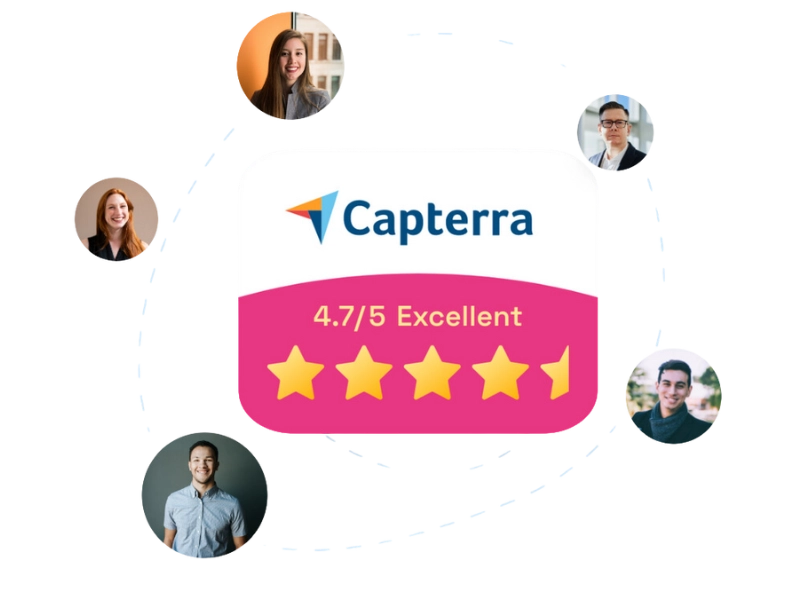Employee Experience: Examples, Tools, and Strategies to Improve It
Rightfully so, companies are paying increasing attention to their relationship with employees to enhance well-being, productivity, and retention. The quality of this relationship is best expressed in the concept of "employee experience".
But what exactly is employee experience? Is it really that important? If so, what methodologies and tools can be used to improve it?
In this article, we will explore the key components of employee experience and how to integrate them into an organization's strategies, especially through the adoption of platforms like the company intranet based on SharePoint Online.

What you will find in this article
- What is employee experience and why is it important
- 4 key processes to improve employee experience
- Employee experience: What is the role of the corporate intranet?
- Our tips for planning the right employee experience strategies
Employee experience: definition and recommended tools
"Employee experience" refers to the experience each person has in their daily professional life during their time within an organization. Every moment, from interactions with colleagues to recognition from management, from the benefits offered to the balance between work and personal life, contributes to defining the quality of this experience.
In the past, the concept of employee experience was considered a secondary matter involving only a small number of organizations. Today, however, more and more companies recognize that it is a crucial strategic component. Nurturing the relationship with employees not only leads to greater productivity but also to increased engagement in the corporate culture, which translates into strong talent retention over time.
These are the reasons why more and more companies are rethinking how they design their work environment, especially in this era where digital transformation plays a central role in the investment and growth strategies of organizations worldwide.
But how can you create an employee experience that truly works?
The answer lies in successfully combining:
- an inclusive corporate culture, focused more on employee well-being;
- a new vision of leadership, based on dialogue and listening to colleagues' needs;
- a modern work environment equipped with the right tools to support daily activities.
This is why it is essential to choose the right technology to digitalize the processes that shape the employee experience. One of the most effective solutions is the company intranet based on SharePoint Online, which benefits from native integration with the Viva suite, the holistic solution designed by Microsoft specifically to strengthen the relationship between employees and companies.
Each module of Microsoft Viva focuses on a key component of the employee experience, with special attention to engagement in culture, goals, and corporate initiatives:
-
Viva Connections supports the engagement phase, allowing the organization to consolidate communications, resources, and essential apps in one central location within the digital workplace.
-
Viva Insights enhances the performance phase by providing detailed analytics on team well-being and productivity, aiming to improve the balance between work and personal life.
-
Viva Learning contributes to the development phase by making continuous learning an integral part of the work routine, helping each employee acquire the necessary skills through personalized learning paths.
-
Viva Topics supports the onboarding phase by helping HR teams organize and make accessible the essential knowledge new hires need to quickly integrate into their new work environment.
-
Viva Engage plays a key role in the engagement and rewarding phases, fostering communication among colleagues, teams, and management through a social media-inspired platform where employees can create themed communities and celebrate achievements together.
-
Viva Goals aligns with the performance phase by enabling organizations to define and track strategic objectives, ensuring continuous alignment across all departments.
-
Viva Glint supports the engagement phase by offering features such as quick surveys and in-depth analytics on corporate communication engagement. It helps companies gain valuable insights based on direct feedback to enhance the work environment.
These tools are not just a support for employees within an organization—they represent a paradigm shift, particularly relevant today as remote and hybrid work models redefine the very concept of a "workplace."
A modern intranet, integrated with Microsoft's innovative technology, can be the key for companies of any size and industry to embrace this new work paradigm, valuing employees and proactively addressing their needs.
This is not about launching a welfare initiative to follow a fleeting market trend, but about making a concrete investment in business growth.
The numbers confirm it: 84% of global companies consider employee experience a priority, and organizations that successfully manage it report up to 25% higher profits compared to those that do not invest in this direction.

Why is it important to take care of an employee experience strategy?
Improving people's experience in the company means enabling them to complete daily tasks quickly, often in just minutes or even seconds, freeing up valuable time to think about new strategies that contribute to the organization's growth.
However, the benefits of a good employee experience go far beyond productivity. A well-designed digital experience also supports employee well-being, promoting a more satisfying and sustainable work environment, aligned with the new vision introduced by the concept of employee experience.
Let's take a closer look at the advantages of this vision.
Better work management
A modern digital environment, such as the one provided by the corporate intranet of SharePoint Online, fosters a healthier balance in daily work life thanks to improved task management, leading to reduced stress levels and a lower risk of burnout.
The integration with Microsoft Viva Insights, for example, allows companies to collect and analyze data on team work patterns to provide personalized recommendations on how to:
- Organize priorities
- Manage the time dedicated to each task
- Plan breaks to reduce fatigue and stress
- Incorporate moments dedicated to well-being and learning
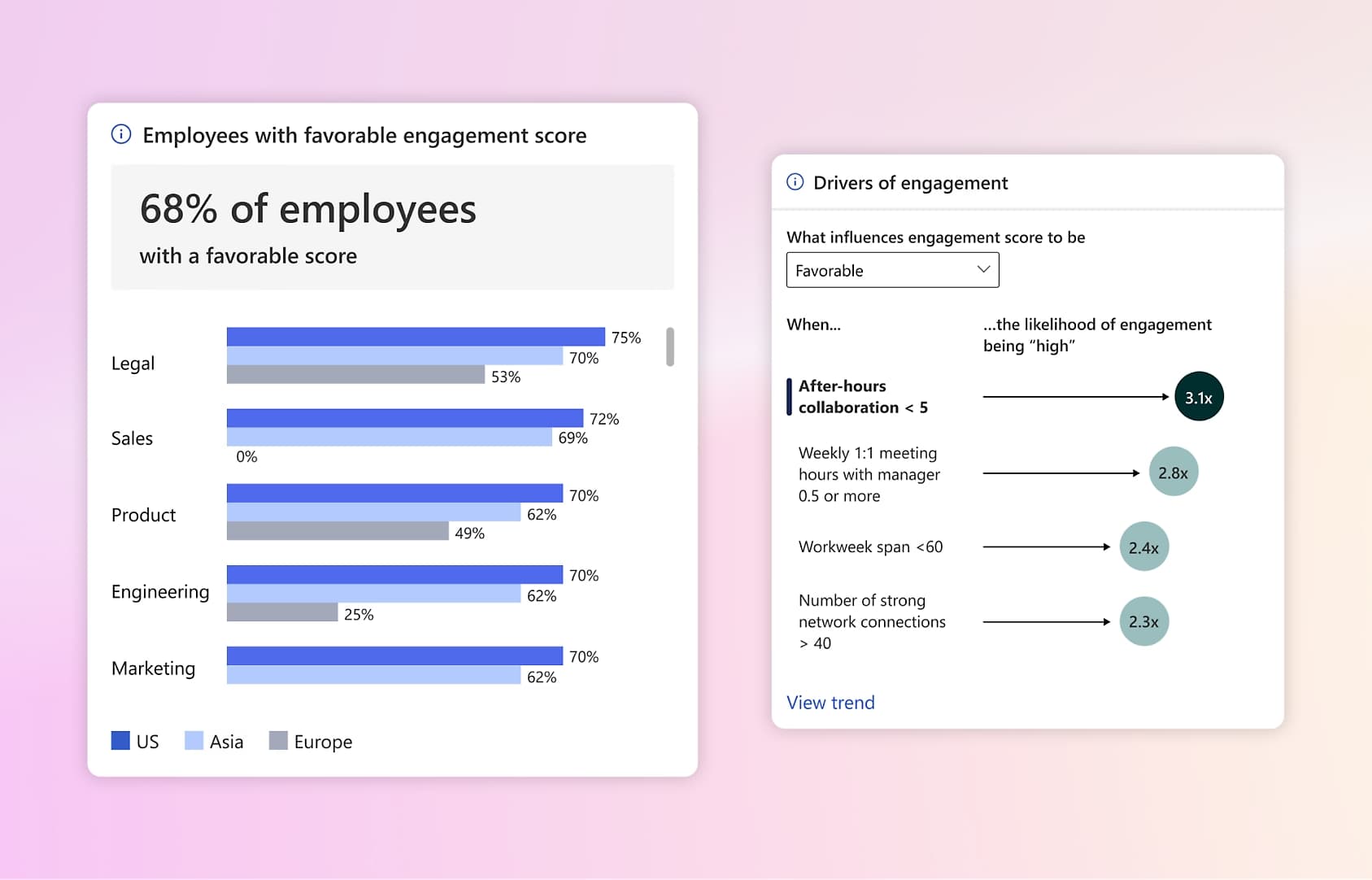
Example of engagement insights provided by Microsoft Viva Insights
Talent retention
As a result of greater attention to the employee experience, turnover-related costs are reduced. According to estimates from the Society for Human Resource Management, these costs can account for up to 33% of the annual salary of the person the company needs to replace.
Employee experience strategies also serve to equip the work environment with tools that can ease daily tasks and make welfare services more accessible.
Companies like Deloitte have chosen to adopt learning platforms capable of providing a wide range of training courses, including personalized ones, to support each employee in developing the skills they consider most important for their career. An opportunity made possible by the Microsoft 365 digital workplace through integration with Viva Learning.
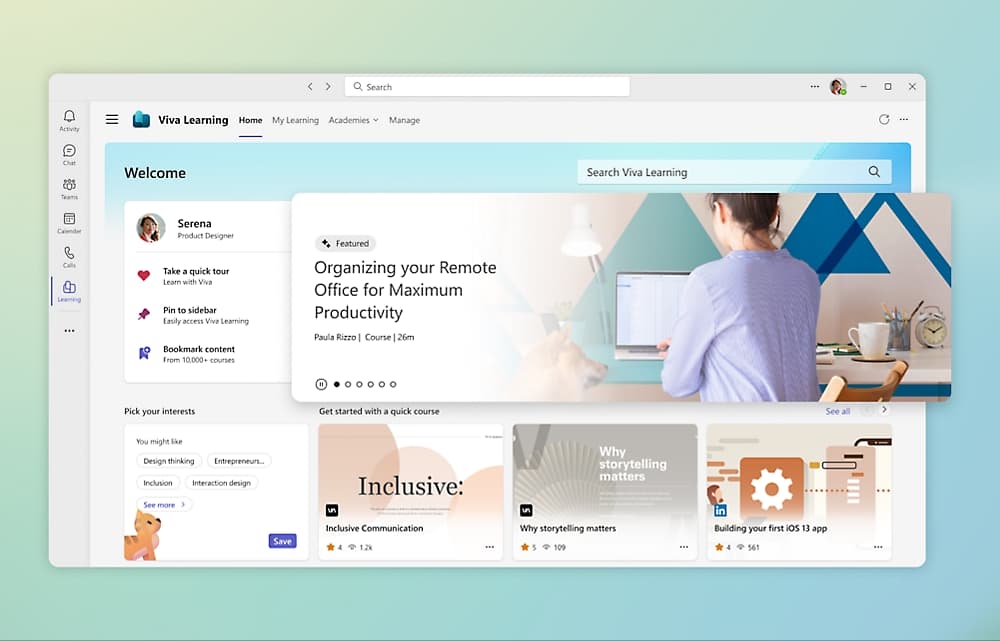
Overview of training courses offered by Microsoft Viva Learning
Greater sense of belonging
Bringing the employee experience into the digital world can also help strengthen the connection between individuals and the corporate community. This is one of the reasons why many organizations have adopted Microsoft Viva Engage, the Viva suite module that, as we mentioned earlier, enables the creation of an internal social networking platform where employees can share ideas, participate in discussions, and get to know their colleagues better through communities.
Communities, in particular, encourage active participation in corporate initiatives by publishing surveys, hosting Q&A sessions with leaders, and sharing stories inspired by the popular feature found on platforms like Instagram and TikTok.
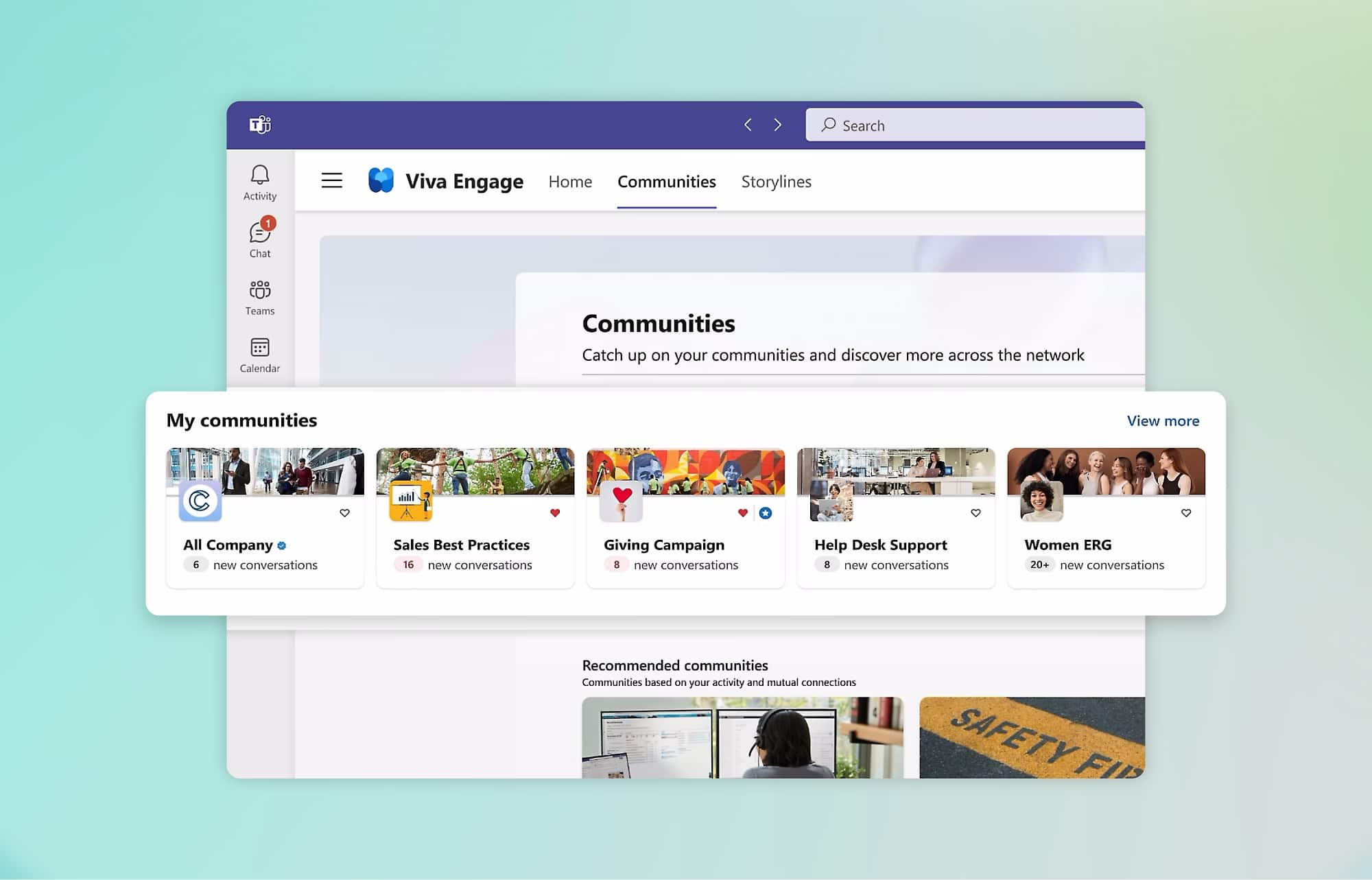
Example of corporate communities that can be created in Microsoft Viva Engage
Greater autonomy
Another fundamental aspect of a good employee experience strategy is the ability for workers to quickly access essential resources and documents, without wasting time on unsuccessful searches or relying on colleagues.
In the SharePoint Online intranet, information is centralized, organized into smart digital archives, and made easily accessible through the integrated search within the entire Microsoft 365 business environment, significantly streamlining the workflow. But that's not all.
Tools like Microsoft Planner and To Do combine with the features provided by SharePoint to help business teams plan shared activities, set priorities and deadlines, and track project progress in real time. Specifically, Planner provides an overview of the individual projects the team is involved in, while To Do allows individual users to integrate their assigned tasks into personal lists, managing them autonomously.
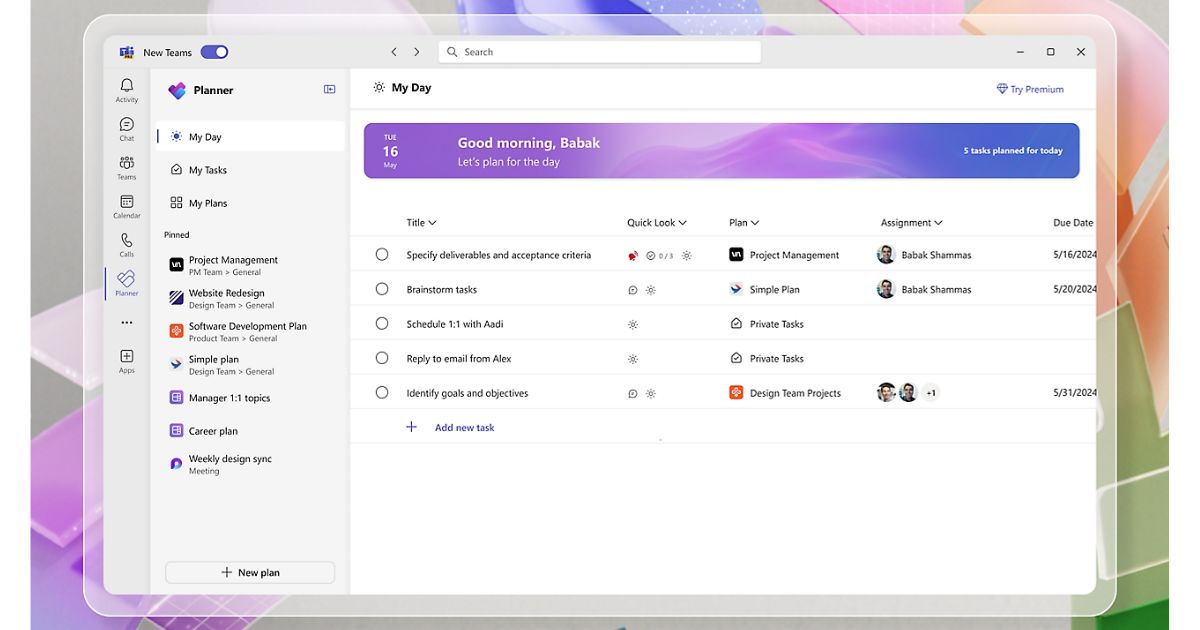
Managing personal and team tasks with Microsoft Planner
Better communication and collaboration
One of the pillars of the digital employee experience is the ability to improve communication and collaboration within the organization. In this regard, the digital workplace based on Microsoft 365 once again proves to be the best solution for companies looking to digitize internal processes with a strong focus on employee experience.
Thanks to tools like Microsoft Teams, it becomes possible to manage communication with colleagues, wherever they are, in real time. Chat, meetings, and integration with key Microsoft 365 and Viva applications are just some of the features offered by Teams to enhance productivity through closer collaboration among corporate teams.
These capabilities have been further expanded with the arrival of Microsoft Loop, which allows for the creation of modular and updatable content that moves fluidly across digital workplace apps.
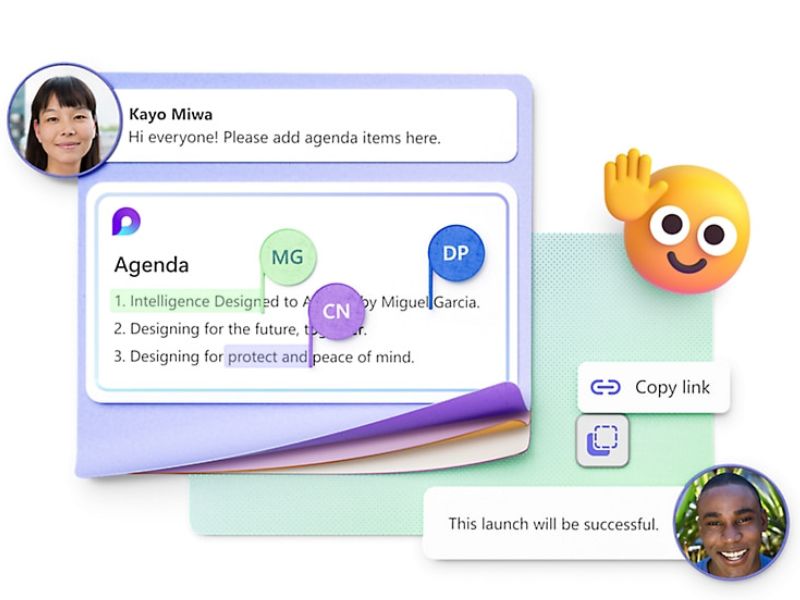
Creating content in collaboration with colleagues using Microsoft Loop
Best practices to improve the employee experience
Today more than ever, companies need to focus on strategies centered around employees' needs to ensure sustainable and continuous growth over time.
This approach, defined as "people centric", also translates into the use of tools that enhance individuals and support them in every aspect of their professional lives.
From continuous skills development to recognition for contributions toward achieving business goals, the new technologies that enable the digitalization of internal processes have the potential to improve the experience across the different stages of an employee's journey within the company:
- Attraction
- Recruitment
- Onboarding
- Engagement
- Development
- Performance
- Rewarding
- Exit
As we have seen, tools like Viva modules provide a dual benefit in relation to each of these phases. On one hand, they simplify human resources management; on the other, they have been proven to increase employee satisfaction levels, leading them to stay longer in the company and proactively contribute to its growth.
Of course, the Viva suite modules are only part of what is considered the modern digital workplace of Microsoft 365, at the heart of which lies the SharePoint Online company intranet.
Starting from the SharePoint intranet, companies can provide employees with a single platform where they can quickly find the information they need, organize project activities, create intelligent and scalable document archives, connect with colleagues, promote events, and share their opinions, to name just a few examples.
Thanks to the native integration between all Microsoft applications, the compatibility with existing corporate systems, and the endless opportunities for automation, the intranet enhances the employee experience by influencing the fundamental processes of any organization:
- Information exchange, making it faster and more structured;
- Internal communication, making it more accessible and engaging;
- Team collaboration, making it more coordinated and seamless;
- Business strategy and related activity management, making them efficient and shared.
Employee Experience: What is the role of the intranet?
1) Information exchange
When information processes within an organization are fragmented or slow, the risk is excessively slowing down operational activities, leading to the frustration of those who cannot find the resources and answers they need in their work environment.
A study conducted by IDC highlighted how companies can lose up to $2.5 million per year due to the difficulties employees face in identifying and retrieving critical information for their tasks.
Modern intranets, such as those based on SharePoint Online, can address inefficiencies that hinder the smooth exchange of information within a company. This is the case with the intranet solution developed by our experts, where the advanced search allows users to obtain relevant results in seconds for the searched terms (even when formulated in natural language), retrieving content from SharePoint and the integrated Microsoft environment.
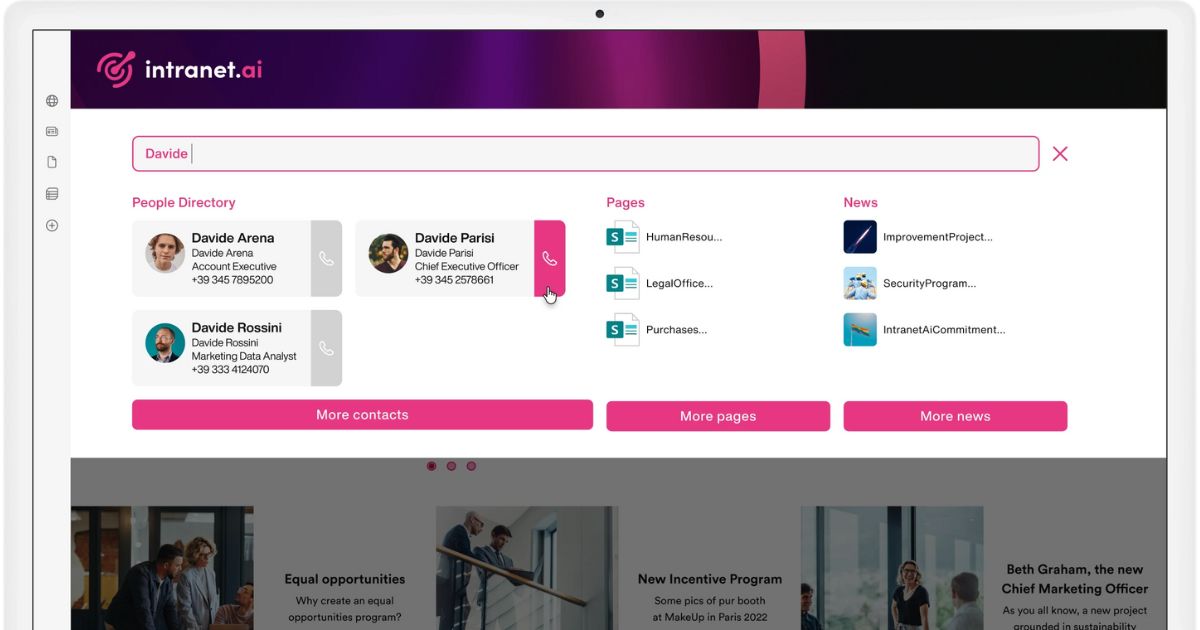
Advanced search in the ready-to-use SharePoint intranet by intranet.ai
A reach that is further extended with the increasingly deep integration of artificial intelligence: from SharePoint Premium to Microsoft 365 Copilot, information management is enriched by tools capable of understanding the context of requests and anticipating users' needs.
Thanks to artificial intelligence, it is no longer just about retrieving information but about obtaining precise answers, personalized suggestions, and predictive analyses that drastically reduce the time spent searching for and sharing information with colleagues.
2) Internal communication
The intranet is the meeting place for all company departments. It is the tool that centralizes and connects the experience of individual employees, providing them with the necessary support to carry out their tasks and coordinate with colleagues, wherever they are and from any device.
The employee experience can evolve within an integrated digital workplace, where it is possible to stay constantly connected with the organization: news, initiatives, updates, and informational pages are easily accessible and enriched with features for sharing ideas, comments, and reactions.
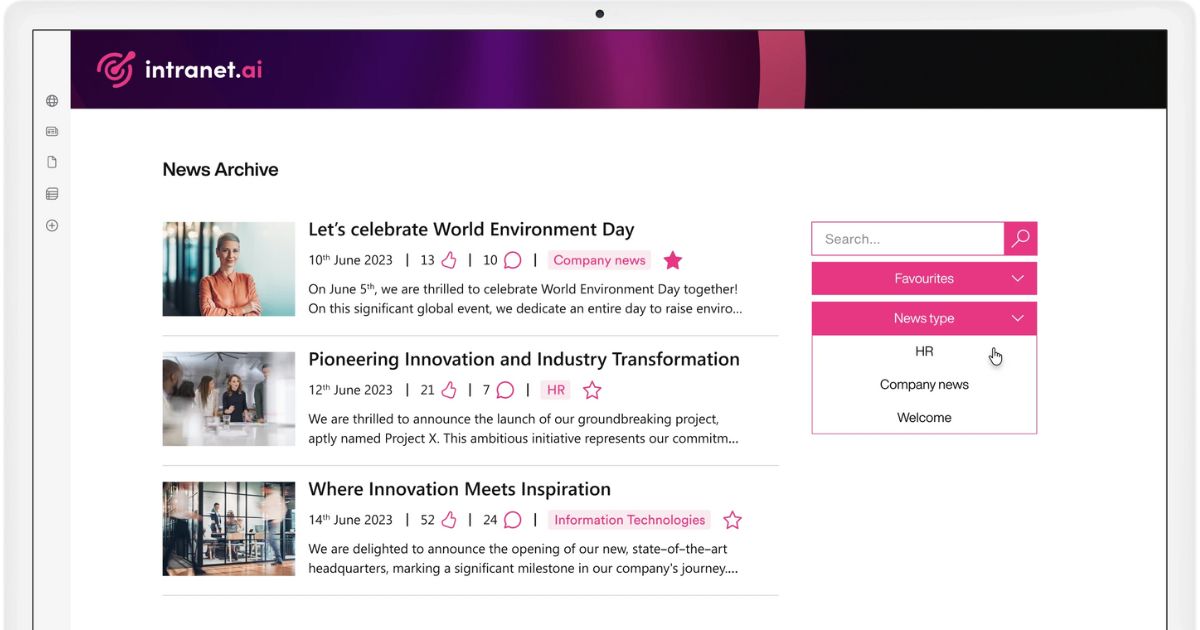
Consulting and analyzing corporate communications in the SharePoint intranet of intranet.ai
3) Team collaboration
As a true hub for company content and applications, the intranet simplifies collaboration between teams and departments.
Thanks to its flexibility, it is possible to create shared workspaces for members of a department, team, or project, even cross-department, improving transparency and coordination needed to achieve all goals within the set deadlines.
Integration with Power Automate also allows for the automation of tasks such as sending notifications for the approval of new project documents or updating shared planners. All of this helps lighten the workload of company teams, giving them the opportunity to focus solely on what truly matters: the quality of the results achieved.
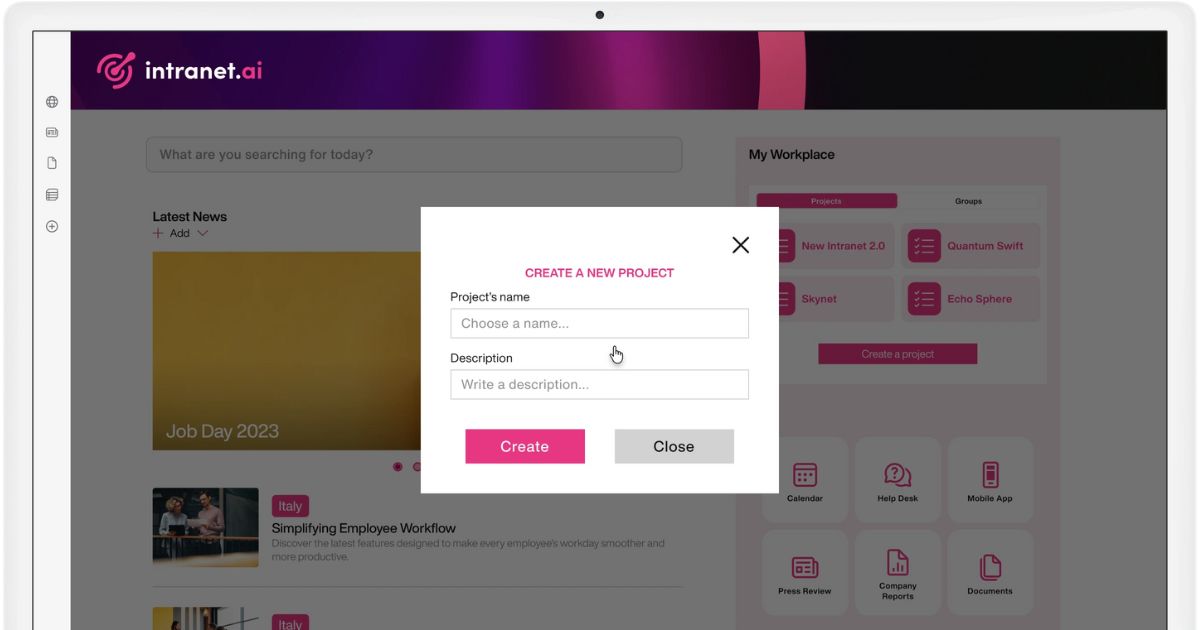
Creating collaboration groups in the SharePoint intranet of intranet.ai
4) Business strategy management
When the management of strategies defined within an organization is not supported by appropriate tools, there is a risk of losing sight of long-term objectives, thus nullifying the efforts made by departments and operational teams.
A SharePoint Online-based intranet can also address this challenge. In fact, it allows for the centralization of planning and tracking of goals at global, team, and individual levels, improving alignment across all levels of the organization.
An example of how this is implemented is through interactive dashboards powered by Power BI, which can be embedded in any portal page. Thanks to this integration, decision-makers can access real-time data on global performance, while employees can view their team's results in real-time and understand how to take action if performance is not meeting expectations.
Other examples include Microsoft Planner and Lists, which enable individual goals to be mapped and aligned with those of the organization.
Additionally, dedicated spaces for sharing feedback foster a two-way communication channel between teams and leadership.
Employee Experience and Employee Engagement
Employee engagement and employee experience are two closely interconnected concepts. As we have seen, employee experience refers to a worker's overall interaction with the company, including aspects such as the technology used, the management of internal processes, and the organization's culture.
Ensuring a good work experience not only improves team satisfaction but also leads to increased engagement, measurable through motivation, productivity, and the willingness to stay with the company in the long term.
According to a study by Gallup, companies that succeed in creating a people-focused work environment report:
- 17% higher productivity
- 21% greater profitability
- 40% lower turnover
This demonstrates that employee experience should now be considered a strategic investment for any organization, and a platform like the SharePoint Online intranet represents the best solution for many businesses to create a modern digital workplace, where productivity increases thanks to greater employee engagement.
For example, the ability to manage shared documents through SharePoint simplifies teamwork, while features such as interactive boards and dedicated brainstorming areas can strengthen employees' sense of belonging to the corporate community.
Another important element is personalization: with SharePoint, it is possible to create specific areas for departments and teams, providing content and tools useful for their daily activities.
For instance, the marketing department could have instant access to campaign calendars, analytical reports, and creative resources, while the HR department could use the intranet to manage the onboarding process, centralize company policies, and promote internal training with content accessible anytime and from any device.

Dedicated areas for departments in the SharePoint intranet of intranet.ai
Strategies for employee engagement
The success of an organization increasingly depends on its ability to create a digital workplace that fosters engagement, communication, and collaboration. The use of tools for gathering feedback, strengthening communication between management and teams, and promoting targeted collaboration groups can be part of a broader employee experience strategy aimed at building a corporate culture more focused on employee engagement.
Below, we explore how an organization can introduce these elements into its digital workplace, always using the corporate intranet based on Microsoft 365 and SharePoint Online as a reference.
Using surveys
Surveys are not just a method for collecting data: they offer the company's employees the opportunity to express themselves and actively contribute to the organization's strategies. At the same time, they provide the company with valuable insights to identify potential areas for improvement in process management and employee communication.
With targeted surveys such as onboarding surveys, designed to collect feedback from new hires, or offboarding surveys, which help understand the reasons behind employee departures, organizations can gather essential information to enhance the employee experience and, in turn, ensure sustainable growth for the entire organization.
For instance, if new hires report difficulties in understanding certain policies, the company could share more detailed guidelines or even implement mentoring programs involving senior colleagues.
There are also 360° surveys, aimed at the entire corporate audience, which help assess internal skills and the quality of workplace relationships. By collecting feedback from department members and management, these surveys can provide useful insights to address inefficiencies in interdepartmental coordination or training gaps among employees.
In the SharePoint Online intranet, surveys and questionnaires created with Microsoft Forms can be integrated. For those unfamiliar, this is the primary feedback collection tool in the Microsoft 365 suite. It allows users to create interactive forms that are highly customizable and easily shareable across the organization or with specific user groups.
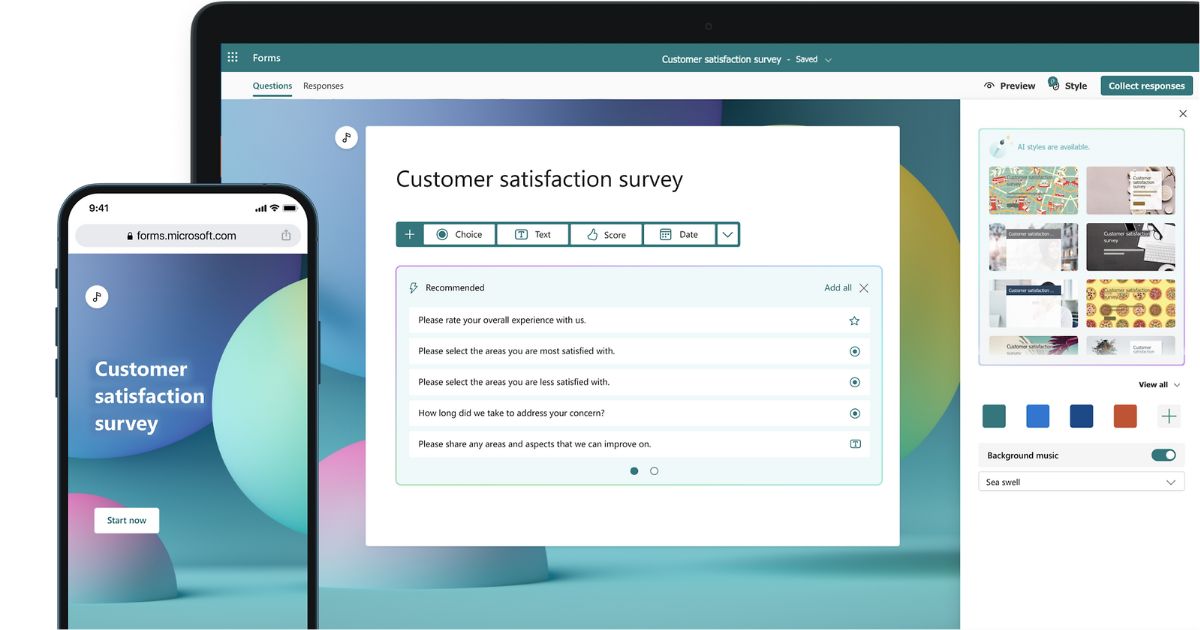
Overview of Microsoft Forms
Additionally, our team has developed a web part dedicated to creating quick surveys directly within the SharePoint intranet.
With the functionality available in the intranet.ai solution, colleagues can be engaged through short closed-ended surveys, useful for assessing the corporate sentiment or gathering opinions on projects and initiatives.
The results are displayed in real time within the intranet, encouraging corporate audiences to visit the portal and follow the survey’s progress.
Standing out for its attractive design and native integration within the platform, our web part allows for a customized user experience based on their department or work location.
Additionally, its ease of use requires no technical skills, making it an ideal tool to foster a more inclusive corporate culture.
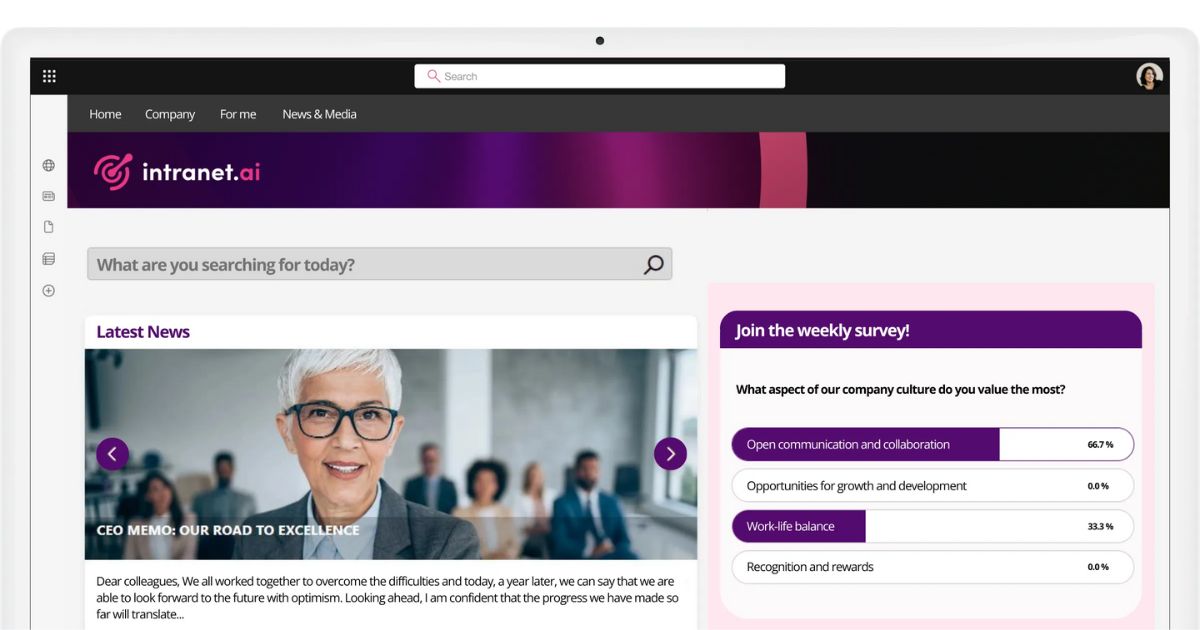
Example of a survey created in the SharePoint intranet of intranet.ai
Recognizing successes while promoting corporate values
One of the most important elements in strengthening the sense of belonging within an organization (and thus engagement) is recognizing colleagues' successes, both at an individual and team level.
On platforms like the SharePoint intranet, it is possible to create a dedicated space for recognition, turning the portal into a place to celebrate achievements and promote corporate values.
For example, a section of the intranet could host a "success board" where the most significant results achieved within a specific time period (month, quarter, or year) are published. These results may include employees who have received an award, passed an exam, completed an important project, or carried out an activity particularly appreciated by colleagues.
An alternative approach could be linking recognition to corporate values. For instance, when a colleague stands out for behavior that embodies one of the company’s values, such as teamwork, they could be featured in an article for a dedicated newsletter on the intranet.

Featured content in the SharePoint intranet of intranet.ai
Gamification
Gamification is an innovative strategy to boost employee engagement by transforming daily activities and corporate initiatives into more enjoyable and stimulating experiences. By using badges, leaderboards, and virtual rewards, companies can motivate employees to actively participate in team-building or training initiatives, to name a few.
Building on what was mentioned earlier, a points system could be implemented to reward participation in surveys published on the intranet.
This approach offers two benefits: on one hand, employees would feel more motivated to spend time answering questions; on the other, the company would gather a larger amount of data related to the survey topic.
But this is just one of the many ways to increase employee engagement in the corporate environment, strengthening their sense of belonging, relationships with colleagues, and, ultimately, their overall experience within the organization.
The following table presents some final examples of how to enhance the employee experience through gamification initiatives offered by the SharePoint intranet.
| Gamification initiative in the intranet | Description |
| Training badges | Award digital badges to users who complete training courses assigned to them or their team. |
| Interaction leaderboard | Display a weekly leaderboard based on the number of comments, likes, and shares of corporate content. |
| Know your colleagues challenge | Monthly quizzes with questions about employees’ interests, skills, and experiences, with prizes for those who achieve the highest scores. |
| Goal-based points collection | Each team earns points by completing corporate activities, such as reaching specific KPIs or participating in events. |
| Sustainability campaigns | Award digital badges and prizes to employees who participate in eco-friendly initiatives such as car sharing. |
| Treasure hunt | Hide clues on intranet pages and reward users who manage to collect them all. This initiative is also valuable in terms of portal adoption. |
Do you want a complete, ready-to-use intranet?
intranet.ai is the SharePoint Online-based solution for simplifying internal communication and digitizing business processes with minimal investment of time and money.
- 50+ features for communication and employee experience
- Branded design, customizable in every detail
- Full integration with Microsoft 365 and Viva
Giuseppe Marchi
Microsoft MVP for SharePoint and Microsoft 365 since 2010.
Giuseppe is the founder of intranet.ai and one of the top experts in Italy for all things Microsoft 365. For years, he has been helping companies build their digital workspace on Microsoft's cloud, curating the people experience.
He organizes monthly online events to update customers on what's new in Microsoft 365 and help them get the most out of their digital workplace.

FAQ on employee experience
What is employee experience?
Employee experience is the overall experience that employees have during their time at a company. It includes aspects such as relationships with colleagues, the use of corporate technologies, work-life balance, and professional growth opportunities.
Why is employee experience important?
Employee experience is crucial because it affects employee well-being, productivity, and engagement. A positive experience strengthens the sense of belonging, reduces turnover, and improves business outcomes, making the organization more competitive.
How can employee experience be improved?
To enhance employee experience, it is essential to combine an inclusive corporate culture, leadership that is attentive to employee needs, and advanced technological tools. Platforms such as SharePoint Online intranet, integrated with Microsoft Viva, provide an effective solution to digitize and optimize business processes.
What is the role of the corporate intranet in employee experience?
The corporate intranet plays a central role in employee experience. It centralizes information, facilitates internal communication, promotes collaboration, and provides quick access to resources and tools needed for daily work, improving both efficiency and employee engagement.
How does Microsoft Viva support employee experience?
Microsoft Viva supports employee experience through modules designed for different needs. Viva Insights analyzes and enhances well-being and productivity. Viva Learning integrates continuous training into workflows. Viva Engage strengthens communication and builds a corporate community, while Viva Goals and Glint support goal setting and collect valuable feedback for the organization.
What is digital employee experience?
Digital employee experience represents the work experience within a digital environment. With tools like SharePoint, Microsoft 365, and Viva modules, employees can quickly access resources, collaborate seamlessly, and simplify daily tasks, improving both productivity and well-being.
What is the impact of gamification on employee experience?
Gamification boosts employee engagement by turning daily tasks and corporate initiatives into enjoyable experiences. Badges, leaderboards, and virtual rewards motivate employees to actively participate, strengthening their sense of belonging and improving interaction with the corporate environment.
Why choose intranet.ai to improve employee experience?
intranet.ai offers a ready-to-use platform based on SharePoint Online, with over 50 integrated features to simplify internal communication, digitize business processes, and enhance employee experience, ensuring a fast and customizable implementation.
Keep on reading
Company Intranet: What It Is, Examples and 20 Ideas to Improve It

Here’s what a corporate intranet is and 20 expert ideas to improve it by streamlining internal processes and enhancing communication among colleagues.
Knowledge Management: Tips and Intranet Tools for Implementation

What is meant by knowledge management? Let's see what it is and how to implement it with examples, best practices, and the best tool: the intranet.
Workplace Bulletin Board: 3 Use Cases in the Intranet


What is a digital bulletin board for? How can you build one? Let's explore this together, along with three use cases in the intranet.
